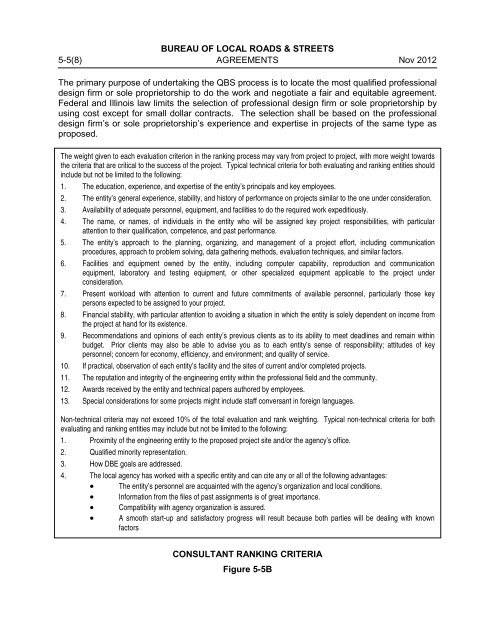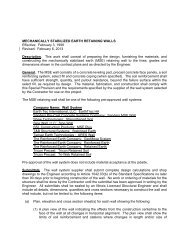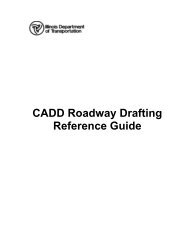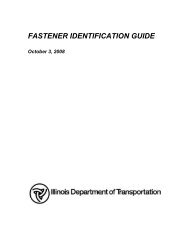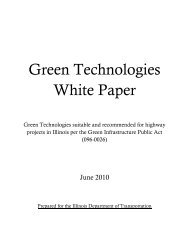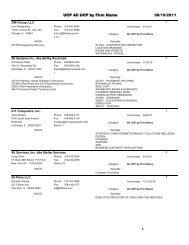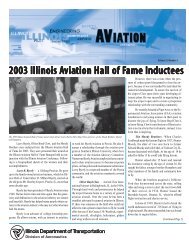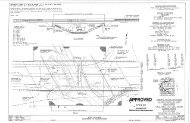Chapter Five AGREEMENTS - Illinois Department of Transportation
Chapter Five AGREEMENTS - Illinois Department of Transportation
Chapter Five AGREEMENTS - Illinois Department of Transportation
You also want an ePaper? Increase the reach of your titles
YUMPU automatically turns print PDFs into web optimized ePapers that Google loves.
BUREAU OF LOCAL ROADS & STREETS<br />
5-5(8) <strong>AGREEMENTS</strong> Nov 2012<br />
The primary purpose <strong>of</strong> undertaking the QBS process is to locate the most qualified pr<strong>of</strong>essional<br />
design firm or sole proprietorship to do the work and negotiate a fair and equitable agreement.<br />
Federal and <strong>Illinois</strong> law limits the selection <strong>of</strong> pr<strong>of</strong>essional design firm or sole proprietorship by<br />
using cost except for small dollar contracts. The selection shall be based on the pr<strong>of</strong>essional<br />
design firm’s or sole proprietorship’s experience and expertise in projects <strong>of</strong> the same type as<br />
proposed.<br />
The weight given to each evaluation criterion in the ranking process may vary from project to project, with more weight towards<br />
the criteria that are critical to the success <strong>of</strong> the project. Typical technical criteria for both evaluating and ranking entities should<br />
include but not be limited to the following:<br />
1. The education, experience, and expertise <strong>of</strong> the entity’s principals and key employees.<br />
2. The entity’s general experience, stability, and history <strong>of</strong> performance on projects similar to the one under consideration.<br />
3. Availability <strong>of</strong> adequate personnel, equipment, and facilities to do the required work expeditiously.<br />
4. The name, or names, <strong>of</strong> individuals in the entity who will be assigned key project responsibilities, with particular<br />
attention to their qualification, competence, and past performance.<br />
5. The entity’s approach to the planning, organizing, and management <strong>of</strong> a project effort, including communication<br />
procedures, approach to problem solving, data gathering methods, evaluation techniques, and similar factors.<br />
6. Facilities and equipment owned by the entity, including computer capability, reproduction and communication<br />
equipment, laboratory and testing equipment, or other specialized equipment applicable to the project under<br />
consideration.<br />
7. Present workload with attention to current and future commitments <strong>of</strong> available personnel, particularly those key<br />
persons expected to be assigned to your project.<br />
8. Financial stability, with particular attention to avoiding a situation in which the entity is solely dependent on income from<br />
the project at hand for its existence.<br />
9. Recommendations and opinions <strong>of</strong> each entity’s previous clients as to its ability to meet deadlines and remain within<br />
budget. Prior clients may also be able to advise you as to each entity’s sense <strong>of</strong> responsibility; attitudes <strong>of</strong> key<br />
personnel; concern for economy, efficiency, and environment; and quality <strong>of</strong> service.<br />
10. If practical, observation <strong>of</strong> each entity’s facility and the sites <strong>of</strong> current and/or completed projects.<br />
11. The reputation and integrity <strong>of</strong> the engineering entity within the pr<strong>of</strong>essional field and the community.<br />
12. Awards received by the entity and technical papers authored by employees.<br />
13. Special considerations for some projects might include staff conversant in foreign languages.<br />
Non-technical criteria may not exceed 10% <strong>of</strong> the total evaluation and rank weighting. Typical non-technical criteria for both<br />
evaluating and ranking entities may include but not be limited to the following:<br />
1. Proximity <strong>of</strong> the engineering entity to the proposed project site and/or the agency’s <strong>of</strong>fice.<br />
2. Qualified minority representation.<br />
3. How DBE goals are addressed.<br />
4. The local agency has worked with a specific entity and can cite any or all <strong>of</strong> the following advantages:<br />
• The entity’s personnel are acquainted with the agency’s organization and local conditions.<br />
• Information from the files <strong>of</strong> past assignments is <strong>of</strong> great importance.<br />
• Compatibility with agency organization is assured.<br />
• A smooth start-up and satisfactory progress will result because both parties will be dealing with known<br />
factors<br />
CONSULTANT RANKING CRITERIA<br />
Figure 5-5B


